Treasury submission to House of Representatives Economics, Finance and Public Administration Committee public inquiry
August2006
Exports of manufactures grew rapidly over the 1980s and 1990s as Australian manufacturers adopted a more global outlook. Growth faltered in the period around the global slowdown in 2001 and has since been adversely affected by the appreciating exchange rate from 2002 to 2004, and by regional competitors increasingly producing more sophisticated goods. Exports of manufactures picked up somewhat from 2004, as the exchange rate stabilised, and export growth continues.
Australians are benefiting from some of the same structural changes in global trade that may have led to slower growth in Australian exports of manufactures. In particular, cheaper imports, in part reflecting rapid industrialisation in China, have substantially increased the spending power of Australian households, contributing to higher living standards than otherwise would have been the case.
While Australia’s own history shows that attempts to ‘protect’ the domestic manufacturing industry are counterproductive, the Government helps Australian manufacturers by providing a sound macroeconomic and institutional environment, through direct assistance and by specific assistance in seeking out export markets.
Introduction
Australia’s exports of manufactures amounted to around $37 billion in 2005, or 4percent of GDP.1 They accounted for around a fifth of the value of Australia’s total exports of goods and services.2 While more than 9,000 manufacturing companies are exporters, over 90percent of exports come from the largest 1,300 of these companies.3 Unlike resource exports, which are disproportionately produced in Queensland and Western Australia, the main sources of manufactures exports are the most populous states of New South Wales and Victoria.
Australia exports a diverse range of manufactures. They include around $10 billion (in2005) of iron, steel and other metals, $7billion of various types of machinery, $5billion of transport equipment, $3 billion of medicines and pharmaceuticals, and $1 billion of professional and scientific instruments. Table 1 summarises Australian manufactures exports by type, input intensity, and end-use.
The major markets for Australian manufactures are Asia (42 per cent, including 9percent to China and Hong Kong, and 7 per cent to Japan), New Zealand (17percent), North America (13 per cent) and Europe (12 per cent), with motor vehicle sales to the Middle East also important. There are significant differences by product, with the more resource-based manufactures going mostly to Asia and the more sophisticated products to Europe, the United States, the Middle East and NewZealand.
Chart 1 places the recent performance of the manufacturing sector, and its role in the Australian economy, into a longer term perspective. As in many advanced economies, the share of manufacturing peaked around the middle of the 20th century. Similarly, (abstracting from war-related disruptions to trade) manufactures rose as a proportion of total exports in the first half of the twentieth century and have tended to become a smaller proportion since, except for the period around the late 1980s and early 1990s when there was rapid growth in Australia’s manufactures exports (Table 1), for reasons discussed later in the paper.
Table 1: Australia’s exports of manufactures
(average annual percentage change; chain volume measure)
|
1986 to 1994 |
1994 to 2000 |
2000 to 2005 |
(Per cent of total 2005) |
|
|
By type |
||||
|
Machinery |
15 |
7 |
2 |
(22) |
|
Metals |
8 |
5 |
-3 |
(24) |
|
Transport equipment |
8 |
14 |
4 |
(16) |
|
Medicine and pharmaceuticals |
19 |
20 |
6 |
(9) |
|
Scientific and photographic equipment |
12 |
16 |
3 |
(5) |
|
Other |
15 |
5 |
3 |
(23) |
|
By input-intensity |
||||
|
Agricultural |
14 |
8 |
1 |
(4) |
|
Resources-intensive |
9 |
5 |
-3 |
(26) |
|
Labour-intensive |
13 |
4 |
3 |
(28) |
|
Mixed |
12 |
11 |
6 |
(26) |
|
Sophisticated |
18 |
17 |
2 |
(17) |
|
By use |
||||
|
Consumer goods |
15 |
13 |
3 |
(35) |
|
Capital goods |
12 |
6 |
4 |
(28) |
|
Materials |
10 |
5 |
-2 |
(37) |
|
Total |
12 |
9 |
2 |
(100) |
Categories are defined on page 87.
Sources: derived from data supplied by Australian Bureau of Statistics.
Chart 1: Australia’s manufacturing sector: proportion of total
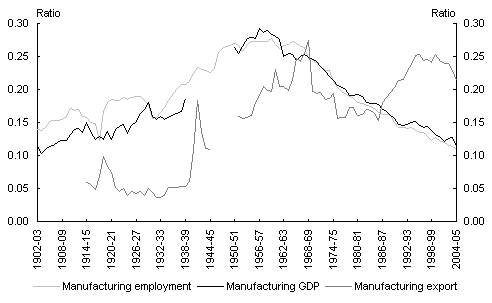
Source: Australian Bureau of Statistics, Reserve Bank of Australia and Bulletin (1962).
Recent trends in manufactures exports
Australia’s exports of manufactures have grown at an annual rate of about 8 percent in volume terms since the mid-1980s. However, there have been some noticeable fluctuations in growth rates over these years (Table 1 and Chart 2).
Manufactures exports grew very strongly in the late 1980s and most of the 1990s, but slowed markedly in the new millennium. Table 1 shows that the slowdown was evident in most types of manufactures. Exports of manufactures picked up in 2005, as the exchange rate stabilised and growth is forecast to continue.
Chart 2: Australia’s exports of manufactures
(Annual percentage change; chain volume measure)
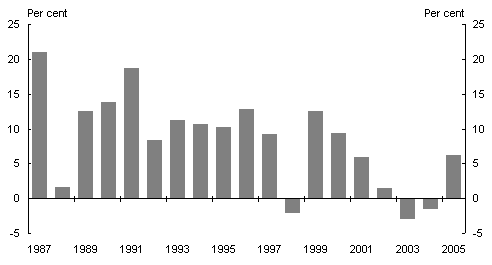
Source: Australian Bureau of Statistics.
Factors influencing manufactures exports
Determinants of export performance include global activity, competitiveness, structural changes and attitudinal developments. The following sections describe developments in each of these factors and reflect on their relative significance in explaining changes in exports of manufactures.
Global economic activity
Over the longer term, world trade volumes have grown considerably faster than world GDP (Chart 3 and Table 2). This is partly a consequence of the demand for variety rising more than proportionately as per capita incomes rise. It also reflects ongoing progress in removing barriers to trade; reductions in transport costs; and greater productivity growth in the tradeable than non-tradeable sector and hence the tendency for traded goods to become relatively cheaper over time; (see, for example, Dean and Sebastia-Barriel (2004)). Recently, the increase in world exports has been driven by the growth of the Chinese economy and its increasing integration with the global economy. Henry (2006; see pages 39-58 of this issue of the Economic Roundup) provides more detail on these developments and their implications for the Australian economy.
Chart 3: World GDP and exports of manufactures
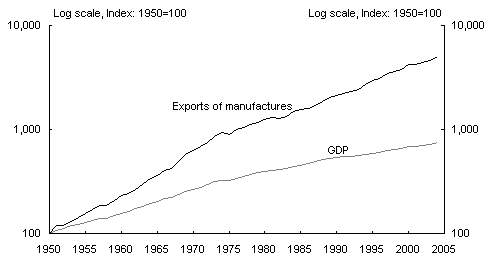
Source: World Trade Organization (2005).
Economic activity in Australia’s trading partners (Table 2) cannot explain much of either the growth spurt in Australia’s manufactures exports from the mid-1980s or the slowdown since 2000.4 Exports of manufactures did pick up globally from the late 1980s to around 2000, and subsequently slowed, but the fluctuations were unusually marked in Australia.
Table 2: Exports of manufactures and global activity
(Average annual percentage change in real terms)
|
1974 to 1986 |
1986 to 1994 |
1994 to 2000 |
2000 to 2005 |
|
|
World GDP |
3 |
3 |
4 |
4 |
|
GDP of Australia’s major trading partners |
4 |
4 |
3 |
3 |
|
World production of manufactures |
2 |
2 |
4 |
2(b) |
|
World exports of manufactures |
4 |
6 |
8 |
4(b) |
|
Australia’s exports of manufactures |
3(a) |
12 |
8 |
1 |
- Financial years 1974-75 to 1985-86.
- 2000 to 2004.
Sources: Australian Bureau of Statistics, World Trade Organization (2005), Treasury estimates.
Australia’s market share
Trends in Australia‘s share of the global market for various types of internationally traded manufactures are illustrated in Chart 4.5 Reflecting Australia’s comparative advantages, our share of world trade in resource-based manufactures is much higher than our share of world trade in labour-intensive manufactures.
Chart 4: Global market share of Australian exports of manufactures
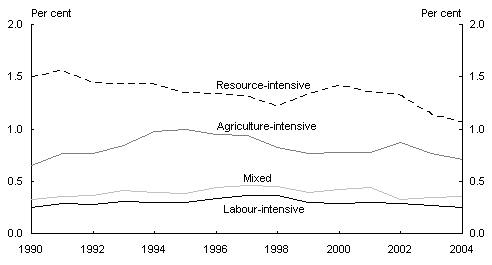
Source: derived from US dollar values of exports from United Nations Commodity Trade Statistics Database. The chart shows Australia’s exports as a share of global exports for the categories described.
In line with the growt
h surge of Australian manufactures exports through the 1980s and 1990s, Australia’s market share in labour-intensive manufactures reached a peak in 1997 while for resource-intensive manufactures the recent peak was reached in 2000. Since then, the emergence of Asian producers, notably China, combined with a slowdown in Australian exports of manufactures, has resulted in a declining market share for most categories of exports.
Relative prices
The price of Australian manufactures exports relative to the prices of world manufactures exports will also affect Australian export performance. The ratio of the ‘world price’ of Australian exports of manufactures to that of global exports of manufactures is shown in Chart 5 (along with the trade-weighted exchange rate).6
The measure of world manufactures prices used in Chart 5 has increased recently — which might signal an end to the downward trend in Australia’s relative price. However, this may be misleading as an indicator of Australian manufacturers’ competitiveness. The prices that have increased most are those of basic manufactures, notably iron and steel, whereas Australia’s manufactures are mostly more sophisticated products.
Chart 5: Relative price of exports of manufactures
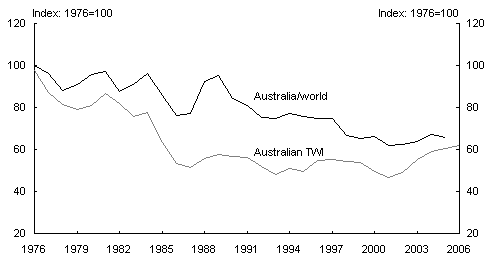
2005 observation for relative price is Treasury estimate.
2006 observation for the TWI assumes it is unchanged over the second half of the year.
Sources: World Trade Organization and Australian Bureau of Statistics.
The other major influence on the relative price has been movements in Australia’s exchange rate. The significant appreciation of the Australian dollar between August2002 and March 2004 eroded the competitiveness of Australian manufacturers; those producing goods with close substitutes made overseas were forced either to cut prices or accept lower export sales. More recently, the currency has stabilised and manufacturers have been able to adjust to the higher level. This is likely to have contributed to the recovery in growth in exports of manufactures in 2005.
The extent to which currency fluctuations or relative price movements affect the demand for Australia’s exports depends on the size of the price elasticity. In Treasury’s economy-wide model, TRYM, the price elasticity for Australia’s non-commodity exports is estimated at only -0.2 in the short run but almost -2 in the long run — that is, in the long run a 10 per cent increase in relative prices leads to a 20 per cent decrease in export volumes.7 On the other hand, a recent IMF (2004) study was unable to detect any influence on Australia’s non-commodity exports from the real exchange rate over 1984-2002.8
One cause of the recent appreciation was the strong growth in the prices of coal and iron ore, and the strong prospects for the resources sector. It is generally acknowledged that a real appreciation resulting from a resources boom can reinforce the slowing of exports of manufactures, a phenomenon known in Australia as the ‘Gregory thesis’ (after Gregory 1976) or, elsewhere, as the ‘Dutch disease’. As well as the exchange rate effect, booming resources sectors may sometimes bid up wages, further eroding the international competitiveness of domestic manufacturers.
Greater sophistication of Asian competitors
While Australia’s exports of more complex manufactures are growing faster than, for example, exports of simple metal products, almost all types of exports of manufactures have slowed significantly (Table 1). The slowing in exports of complex manufactures is consistent with rival producers, notably in Asia, becoming increasingly able competitors. This argument has been mentioned by manufacturing industry spokespeople, who note the growing integration of Chinese manufacturers within Asian supply chains (Ridout 2004).
Manufacturers became exporters in the late 1980s and early 1990s
From the mid-1980s, there was a cultural change among Australian manufacturers — a growing belief in ‘internationalisation’. A ‘new breed’ of manufacturers adopted a more outward outlook, and increased the proportion of production they exported.9 There were a number of factors behind this change in attitude.
Since the mid-1980s, manufacturing production volumes have grown at an average annual rate of below 2 per cent. In contrast, the export volumes of manufactures grew at an annual average rate of around 11 per cent from the mid-1980s to the turn of the century. This shift was broad-based, with many parts of the manufacturing industry experiencing exceptional growth in their exports during this period — as shown in Chart 1 and Table 1. It seems likely that at least part of the slowdown in manufactures exports since 2000 has been a result of this adjustment coming (inevitably) to an end.
The sharp depreciation of the currency soon after it was floated in 1983 (Chart 5 above) made potential exporters suddenly more competitive, and may have encouraged them to pay the fixed costs necessary to enter export markets. There were ‘demonstration effects’ as newly successful exporters encouraged others to enter export markets. There may also have been a ‘vanguard effect’ whereby exporters entering new markets (establishing a ‘beachhead’) made it easier for others to follow, such as by sharing their experiences.
The drive into export markets was also spurred by cuts in tariffs, both in Australia and in potential export markets. The average effective rate of assistance for manufacturing in Australia fell from 35 per cent in the late 1960s to under 5 per cent now (Chart 6) with further falls over coming years in train.
Chart 6: Effective rates of assistance for Australian manufacturing
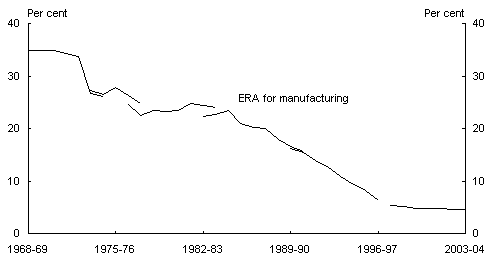
Source: Dolman, Lu and Rahman (2006).
It was also probably helped by financial deregulation which made it easier for firms to borrow to expand overseas, and to manage the resultant currency exposures. The slower growth in real unit labour costs in the late 1980s and early 1990s, and the increased flexibility in labour markets, may also have contributed.
Government support for manufactures exporters
Government can establish a positive business environment, including for manufactures exporters, by:
- ensuring the economy’s fundamentals are conducive to ongoing investment through the application of sound macroeconomic and microeconomic policy;
- removing unnecessary impediments to business activity such as inefficient government processes or excessive regulation;
- encouraging human capital formation through the right wage and price signals; and
- encouraging the pursuit of productivity gains from increasing competition in traded and non-traded sectors.
This helps underpin a low inflation, low interest rate, high economic growth environment and enhances national productivity performance, giving business a sound basis on which to plan expansions into export markets. Furthermore, Australia’s pursuit of trade liberalisation (refer Chart 6) and lower global tariffs provides manufactures exporters with better access to overseas markets and reduces the cost of their inputs.
In some cases, where there are clear benefits to the econ
omy from specific government intervention, it may be appropriate to implement: measures to align the private and social benefits or costs of a given activity; measures to address market rigidities and transitional costs as resources move to alternative uses; and measures to improve information available to market participants. The most effective initiatives are those that are broad-based, thereby limiting market distortions and allowing individual firms to select the most profitable investments.
There continues to be specific support provided to Australian manufacturers in seeking out new export markets. Austrade, the Government’s trade promotion agency, reduces the time, cost and risks involved in choosing, entering and developing international markets. It provides practical advice and information on potential export opportunities and how these can be realised. In 2004-05, Austrade assisted over 4,000 clients to achieve export deals valued at $18.4 billion. It also provides financial assistance to small and medium enterprises through the Export Market Development Grants programme. On 24 January 2006, the Government announced that this programme would be extended for another five years until mid-2011.
The Export Finance and Insurance Corporation facilitates Australian exports by providing finance and insurance services to Australian exporters and their financiers. It operates in ‘gaps’ in the market by supporting transactions that the private insurance sector does not have the capacity or willingness to support due to excessive political or commercial risk.
There are also some industry-specific measures for manufacturers. On 13December2002, the Government announced a $4.2 billion extension to the Automotive Competitiveness and Investment Scheme. The scheme encourages strategic investment and research and development in the Australian automotive industry and the establishment of links between Australian producers and the global industry. The Government also provides a package of assistance measures for the textile, clothing and footwear industry valued at $747 million, a significant proportion of which is intended to promote investment and innovation as a means of increasing the productivity and competitiveness of industry participants.
The Government has put in place measures to ensure that import tariffs do not disadvantage Australian exporters. The Duty Drawback Scheme reduces costs for exporters by around $120 million per annum by allowing exporters to claim a refund on duty paid on imported goods when those goods are used as inputs for exported products or exported themselves. In addition, the Tradex Scheme provides up-front exemptions, worth $93 million in 2004-05, from duty and GST on imported goods that are intended for export or used in the manufacture of other goods exported later on. Furthermore, in the 2005-06 Budget, the Government reduced costs for affected businesses by $1.3 billion over five years by removing the 3 per cent tariff on business inputs where no substitutable goods are manufactured in Australia. By reducing costs, these measures improve the ability of Australian exporters to compete in international markets. The Government's recent improvement to Australia's depreciation regime, increasing the diminishing value rate to 200 per cent, increases incentives for Australian businesses to invest in new plant and equipment. In total, the Productivity Commission (2006) estimates government assistance to manufacturing at $1.8 billion in 2004-05, accounting for the largest proportion (at 42 per cent) of total Australian assistance to industry.
Current policy pressures
Australians are benefiting from the recent structural changes in the global economy. In particular, cheaper imports of consumer goods, in part reflecting rapid industrialisation in China, have substantially increased the spending power of Australian households, contributing to higher living standards than otherwise would have been the case. Furthermore, Australian manufacturers are able to buy some types of equipment more cheaply as a result of China producing them. Australian shareholders in resource companies, including many working Australians who indirectly hold shares through their superannuation funds, are earning higher incomes which when spent will benefit Australian manufacturers and service providers. Australians benefit from the services funded by increased tax collected from higher levels of economic activity associated with the resources boom.
However, these same global changes may have led to slower growth in Australian exports of manufactures. They are likely to result in some restructuring of the economy towards areas of comparative advantage, such as the resources sector. To take advantage of new opportunities and the prospect of higher returns, firms, investors and workers will reallocate resources.
This process of restructuring will take time, however, and in the short term, social and economic costs may motivate pressure for government intervention. There are many economic studies finding that structural adjustment support works best if it is targeted to the welfare of individuals rather than the protection of jobs or industries; for example, Blanchard (2005). Effectively targeted measures (such as retraining programmes or relocation assistance) that enhance individuals’ capacity to adjust to economic changes can be beneficial.
By contrast, measures such as tariffs or subsidies, which protect firms that can no longer generate an economic return, and impede the transition process, will provide only short-term benefit to manufacturers while leading to higher prices for all businesses and consumers and long-term inefficiencies and rigidities, lowering standards of living.
Moreover, international trade agreements to which Australia is a party limit our capacity to increase tariffs unilaterally or subsidise manufactures exports. As part of our commitments to the World Trade Organization (WTO), Australia has agreed to limit the maximum level for almost all of its tariffs in return for similar commitments from other WTO members. In addition, subsidies for non-agricultural goods that are specifically designed to encourage exports or favour the use of domestic over imported inputs are prohibited under WTO rules. Australia's free trade agreements also limit our capacity to impose tariffs on goods imported from several major trading partners. In return, however, Australian exporters benefit from greater access to overseas markets.
There are concerns expressed that the resources boom may be short-lived. And once a factory is shifted overseas, or a contract lost, it may be difficult to expand manufactures or other non-resource exports again even if, after the resources boom fades, the exchange rate appreciation is reversed. However, governments are no better placed than firms and investors, responding to signals in the market, to determine whether a shock is temporary. Instead, the government can more effectively help the economy achieve its productive potential by allowing the market to operate unimpeded and allow resources to flow to their most efficient use. This will achieve improved productivity, economic growth and expanded national income in the long term.
To this end, implementation of the reforms to infrastructure, human capital, regulation and competition under the Council of Australian Governments’ National Reform Agenda will support the business environment. Together with reforms to labour and product markets and the continuation of responsible fiscal management and the pursuit of trade liberalisation by the Government, these policies will improve the flexibility of the domestic economy and ensure its continued strong performance.
References
Australian Bureau of Statistics 2001, ‘Manufacturing in the twentieth century’, YearBook Australia 2001.
Australian Bureau of Statistics 2002, Manufacturing industry 2000-01
, cat. no. 8221.0, 28October.
Australian Bureau of Statistics 2004, ‘Australia’s exporters, 2003-04’, downloaded from
Australian Industry Group 2006, ‘Manufacturing futures: achieving global fitness’, April.
Blanchard, O 2005, ‘European unemployment: The evolution of facts and ideas’, NBER Working Paper 11750, November.
Bullock, M Grenville, S and Heenan, G 1993, ‘The exchange rate and the current account’, The Exchange Rate, International Trade and the Balance of Payments, edBlundell-Wignall, A, Reserve Bank of Australia.
Butlin, N 1962, Australian Domestic Product, Investment and Foreign Borrowing 1861-1938/39, Cambridge University Press.
Coppel, J and McLean, B 2002, ‘Trends in Australia’s exports’, Reserve Bank of Australia Bulletin, April, pp 1-5.
Dark, D and Hawkins, J 2005 ‘Why have Australia’s imports of goods increased so much?’, Economic Roundup, Summer 2004-05, Australian Treasury, pp 33-44.
Dean, M and Sebastia-Barriel, M 2004, ‘Why has world trade grown faster than world output?’, Bank of England Quarterly Bulletin, Autumn, pp 310-20.
De Roos, N and Russell, B 2002, ‘The exports transmission mechanism of foreign business cycles to Australia’, Economic Record, vol 78, No. 240, pp 50-9.
Dolman, B Lu, L and Rahman, J 2006, ‘Understanding productivity trends’, Economic Roundup, Summer 2006, Australian Treasury, pp 35-52.
Gregory, R 1976, ‘Some implications of the growth of the minerals sector’, Australian Journal of Agricultural Economics, vol 20, No. 2, August, pp 71-95.
Henry, K 2006, ‘Implications of China’s re-emergence for the fiscal and economic outlook’, Economic Roundup, Winter, pp 39-58.
International Monetary Fund 2004, ‘Australia: selected issues’, IMF country report, No.04/354, November.
Menzies, G and Heenan, G 1993, ‘Explaining the recent performance of Australia’s manufactured exports’, Reserve Bank of Australia Research Discussion Paper, No. 9310, August.
Productivity Commission 2003, Trends in Australian Manufacturing, Commission Research Paper, AusInfo, Canberra.
Productivity Commission 2006, ‘Trade and assistance review 2004-05’, Productivity Commission Annual Report Series, April, AusInfo, Canberra.
Rees, C 2004, ‘Australia’s exports continue to strengthen‘, Trade Topics: September Quarter 2004, Department of Foreign Affairs and Trade, December, pp 2-3.
Ridout, H 2004, ‘China — terms of engagement’, speech to Sydney Institute, 17November.
World Trade Organization 2005, International Trade Statistics 2005, Geneva.
Annex on data
The classifications used in Table 1 are based on Standard International Trade Classification divisions as follows; Machinery is divisions 71-77; Metals is 67-69; Transport equipment is 78 and 79; Medicine & pharmaceuticals is 54; Scientific and photographic equipment is 87 and 88; Other is 51-53, 55-59, 61-66, 81-85 and 89; Agricultural is 61, 63 and 64; Resource-intensive is 52 and 66-68; Labour-intensive is 57, 58, 65, 69,71-74, 77, 81-85 and 89; Mixed is 51, 53, 55, 56, 59, 62, 75, 78 and 79; Sophisticated is 54, 76, 87 and 88; Consumer goods is 54, 55, 62, 69, 76, 78, 81-85, 88 and 89; Capital goods is 71-75, 77,79 and 87; and Materials is 51-53, 56-59, 61 and 63-68.
Different definitions had to be used in Chart 4, as some SITC divisions were unavailable for the world. Labour-intensive is defined as divisions 69, 71-79 and 81-89. Agriculture-intensive is divisions 61 and 63 and resource-intensive is 64 and 66-68.
1 In this paper, ‘manufactures’ is taken to include Standard International Trade Classification sections 5, 6, 7 and 8. It therefore excludes divisions which some authors include as manufactures, such as sugar and beverages.
2 For a short history of Australia’s manufacturing industry, see ABS (2001). For a more detailed analysis of recent trends, see Productivity Commission (2003). For short analyses of all Australian exports, see Coppel and McLean (2002), Australian Bureau of Statistics (2004) and Rees (2004).
3 Exporters are defined as companies exporting more than $10,000 worth of goods per annum. In addition to those manufactures exported directly by manufacturing companies, significant amounts were exported by the wholesale trade industry and some semi-processed materials were exported by the mining industry; Australian Bureau of Statistics (2004).
4 A more rigorous analysis requires information on the size of the income elasticity of demand for Australia’s exports of manufactures. The income elasticity for Australia’s imports (which are mostly manufactures) is around 1.2; Dark and Hawkins (2005). Estimates of income elasticities for exports in the G7 economies are mostly between 1 and 2.
5 Therefore, the line marked ‘resources-intensive’ shows Australia’s exports of these types of exports divided by the global exports of resource-intensive exports. Chart 3 is based on USdollar values of exports, not the volume data primarily used elsewhere in this paper.
6 Chart 5 shows the relative price that affects the demand for Australian exports. There may also be a role for another relative price that affects the supply of exports. This could be constructed as the price of Australian exports relative to domestic costs. However, when Bullock, Grenville and Heenan (1993) ran regressions for Australian exports of manufactures with both relative price terms, they found that the latter relative price was insignificant.
7 Dark and Hawkins (2005) conclude that the price elasticity of Australia’s demand for imports, which are mostly manufactures, is around -.
8 De Roos and Russell (2002) also find no significant price effect, which they suggest could be due to difficulties in distinguishing supply and demand effects.
9 The term ‘new breed’ is used in Australian Industry Group (2006). See Bullock, Grenville and Heenan (1993) and Menzies and Heenan (1993) for further discussion of this change. The latter paper reports a structural break in the mid-1980s in econometric analysis of Australia’s exports of manufactures.